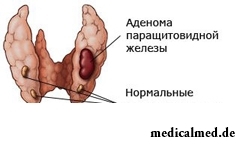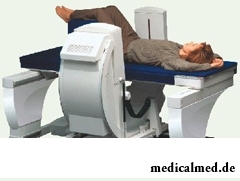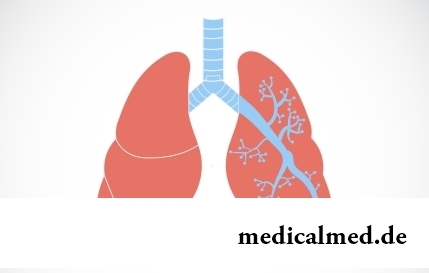





Hyperparathyreosis
General characteristic of a disease

The hyperparathyreosis (it гиперпаратироз) is an endocrinological disease at which in a human body there is hypersecretion of hormones of epithelial bodies. As a result of it in bone system the amount of calcium increases, and the hypercalcemia syndrome develops. Because of it durability of bones decreases and there is an increased probability of bone changes.
Long time the hyperparathyreosis was considered as quite rare disease. However thanks to the modern level of medical technologies it was succeeded to find out that rare pathology actually is only the hyperparathyreosis with a considerable surplus of hormones of epithelial bodies.
The disease of small expressiveness occurs on average at one of 500 people. Diagnosis of a hyperparathyreosis quite often happens during planned medical examination.
The disease can be primary or secondary form.
Primary hyperparathyreosis
As the reason of development of primary hyperparathyreosis in 85% of cases serves epithelial body adenoma. It is accepted to call a single form of a tumor solitary paratiromy. Lead multiple benign tumors or malignant new growths of epithelial bodies to primary hyperparathyreosis much less often. Other possible reason of primary hyperparathyreosis – a hyperplasia of epithelial bodies.
Hyperproduction of parathormones causes excess removal by kidneys of phosphates, accelerates absorption of calcium in intestines and breaks exchange processes in a bone tissue. At primary hyperparathyreosis the speed of a resorption (destruction) of a bone tissue exceeds osteogenesis speed.
As a result at the patient with a hyperparathyreosis generalized osteoporosis (thinning and deformation of bones), an osteodystrophy (the accelerated destruction of bones) develops.
Among complications of primary hyperparathyreosis call damages of fabrics of renal tubules and a nephrocalcinosis (formation of stones in kidneys). Large amounts of calcium in urine significantly reduce function of kidneys of the patient.
Other widespread complications of primary hyperparathyreosis:
- calcification of blood vessels,
- increase in arterial pressure,
- intestines cankers,
- hypertrophy of a left ventricle of heart,
- valve and coronary kaltsinata (deposits of salts in heart).
Secondary hyperparathyreosis
The attempt of an organism to compensate a hypocalcemia (deficit of calcium in an organism) or a hyperphosphatemia (a surplus of phosphates) leads to development of a secondary hyperparathyreosis.
Diseases of kidneys and GIT are considered as the main reasons for a secondary hyperparathyreosis. For example:
- renal rickets,
- chronic renal failure,
- primary tubulopatiya (disturbances of transportation of substances in membranes of renal channels),
- sprue (bad absorbability of a small intestine).
Also can lead bone pathologies and fermentopatiya at genetic or general autoimmune diseases to a secondary hyperparathyreosis.
One more possible provoker of a secondary hyperparathyreosis – malignant new growths in marrow (multiple myeloma).
Hyperparathyreosis symptoms
The disease is characterized by total absence of symptoms at an initial stage of development. Diagnosis of a hyperparathyreosis at this stage is possible only on the basis of the found hypercalcemia.
Carry to renal symptoms of a hyperparathyreosis:
- polyuria (urine hypersecretion),
- polydipsia, (syndrome of strong thirst),
- nephrolithiasis (stones in kidneys),
- frequent cases of pyelonephritis (inflammation of kidneys).
 Symptom of a hyperparathyreosis of heavy degree – development of a renal failure.
Symptom of a hyperparathyreosis of heavy degree – development of a renal failure.
Bone symptoms of a hyperparathyreosis it:
- frequent changes,
- osteoporosis,
- chondrocalcinosis (destruction of cartilaginous tissue of joints).
Gastrointestinal symptoms of a hyperparathyreosis:
- anorexia (lack of appetite),
- meteorism,
- nausea,
- peptic ulcer of a duodenum and stomach,
- pancreatitis (pancreas inflammation),
- панкреакалькулез (stones in a pancreas).
At the long course of a disease cardiovascular symptoms of a hyperparathyreosis and frustration of TsNS are shown:
- arterial hypertension,
- depression,
- hypererethism or drowsiness,
- confusion of consciousness.
At a secondary form of a disease symptoms not of a hyperparathyreosis, and the main disease, as a rule, of a renal or gastrointestinal etiology prevail.
The heaviest complication of primary or secondary hyperparathyreosis - giperkaltsiyemichesky crisis. At the patient with calcium indicators in a blood plasma higher than 4 mmol/l sharply accrue weakness, drowsiness, dehydration, fever, and then coma develops.
Diagnosis of a hyperparathyreosis
The hypercalcemia as the main symptom of a hyperparathyreosis, is diagnosed by means of routine biochemical analysis of blood. In diagnosis of a hyperparathyreosis simultaneous identification in blood of sick deficit of phosphates and the raised indicators of phosphate salts, an alkaline phosphatase, hydroxyproline amino acid, and also TsAMF (cyclic adenosinemonophosphate) is also important.
For assessment of function of epithelial bodies in diagnosis of a hyperparathyreosis the level of parathormones in blood is checked.
Refer to tool diagnostic methods of a hyperparathyreosis ultrasonography, MPT and KT of area of a mediastinum and a neck, the roentgenogram of bones. The procedure of osteodensitometry allows to measure density of bones. Thanks to use of an ECG in diagnosis of a hyperparathyreosis cardial complications of a disease are defined.
Genetic diagnosis of a hyperparathyreosis is applied at family forms of a hypercalcemia.
Treatment of a hyperparathyreosis
Primary hyperparathyreosis – slowly progressing disease. At a hypercalcemia lower than 3 mmol/l treatment of a hyperparathyreosis, as a rule, is not carried out. The patient needs only dynamic observation.
Conservative treatment of a hyperparathyreosis is limited to elimination of a condition of a hypercalcemia. For this purpose plentiful drink is recommended to the patient in uncomplicated cases. In an urgent situation in conservative treatment of a hyperparathyreosis diuretic drugs and intravenous administration of Sodium chloride for increase in volume of the circulating blood are used.

In addition sick with symptoms of primary or secondary hyperparathyreosis rates of biphosphonates can be appointed. These drugs slow down destruction of bones and normalize calcium level in an organism. However at their reception some side effects are possible: muscle pain, fervescence and high level of creatinine in blood.
The effect of use of kaltsimimetik in treatment of a hyperparathyreosis is still insufficiently studied.
Radical method of treatment of a hyperparathyreosis - surgery at tumors of epithelial bodies. After removal of a paratiroma a course of conservative therapy is conducted to eliminate a condition of a hypercalcemia.
Absolute indications for surgical treatment of a hyperparathyreosis are:
- single tumor of epithelial bodies,
- young age of the patient,
- high degree of a hypercalcemia,
- renal failures,
- considerable reduction of bone weight.
Possible methods of surgical treatment of a hyperparathyreosis – a subtotal or total parathyroidectomy. In the first case are not removed only 50-70g the least changed fabrics of epithelial bodies.
Efficiency of surgical treatment of a hyperparathyreosis more than 97%. The recurrence of a disease is possible only at genetic forms of a syndrome of a hypercalcemia.
More than 500 million dollars a year are spent for allergy medicine only in the USA. All of you still believe that the way to finally win against an allergy will be found?

They say that to ensure health and longevity of people it is obliged. Really, at competent approach to these questions, we will pass...
Section: Articles about health
What they, women? Beautiful, gentle, passionate and at the same time windy, gusty, and nervous. And what is stranger: have all these qualities of the woman at the same time. But here only the mood their time sharply changes on completely opposite: in the morning...
Section: Articles about health
Proofs of efficiency of Mildronate at treatment of coronary heart disease with stenocardia can be found in many publications of the end of the twentieth century. Researches were conducted since 1984, including placebo - controlled effects. In total clinical tests of Mildronate were carried out for more than thirty years....
Section: Articles about health
The body of the person almost for 60% consists of water. It is so important for normal functioning of an organism that loss of all is ponut...
Section: Articles about health
Bathing in broths of medical flowers and plants (phytobathtub) was eurysynusic since Cleopatra who is a good judge in all that concerns beauty and health. And today phytobathtubs is the simple and available means allowing not only to remove nervous N...
Section: Articles about health
Use of medicinal plants in therapy is urgent today, more than ever. The drugs made of curative herbs cannot replace completely modern synthetic drugs, but their use becomes frequent serious help in simplification of a course of many illnesses and improvement of quality of life of chronic patients....
Section: Articles about health
Visit of doctors – business not the most pleasant, and many people do not hurry to undergo necessary planned inspections. Such behavior...
Section: Articles about health
History of mankind contains several tens of epidemics whose emergence was compared by eyewitnesses and historians to doomsday. The most terrible of them claimed the lives of millions of people, having made even the whole people to the person of the earth. What they − the diseases striking terror? Daringly...
Section: Articles about health
Statistically, pathologies of a thyroid gland in the world more than 500 million people have. Failures in work of this body lead to heavy disbolism, development of heart diseases, vessels, a reproductive and nervous system. In hard cases excess or insufficient production of the main hormones of a thyroid gland (thyroxine and triiodothyronine) leads to essential decline in quality of life and disability....
Section: Articles about health
Healthy lifestyle today in fashion, and many parents think of that the child from the early childhood played sports. To a Torah...
Section: Articles about health
The person, as well as all other beings living on our planet feels weather changing. It is the normal meteosensitivity which is not causing to healthy people of special troubles. Meteodependence, on the contrary, is morbid condition, характеризующимс...
Section: Articles about health
Residents of big cities quite often have a disease which is known as the syndrome of chronic fatigue (SCF) today. This illness affects the people belonging to various social and demographic groups and living on all continents. Most of all SHU are subject women aged from 25 up to 45 years. Statistically, the number of cases fluctuates in the different countries from 10 to 37 people on 100 thousand, but specialists believe that these figures are significantly underestimated as people, страдающ...
Section: Articles about health
Each woman has preferences in the field of use of those goods which help us to look good, feel се...
Section: Articles about health
Good appetite was always considered as a sign of good health. The correct operation of the mechanism which is responsible for the need for nutrients and receiving pleasure from process of its satisfaction demonstrates that the organism functions without special from...
Section: Articles about health
Since the moment when the child becomes a school student, his sight begins to be exposed to the strengthened loadings which are supplemented with viewing of animated films and long computer games. During this period of life of the child development of not completely created organs of sight, it is very easy to break the excessive loading which is aggravated with lack of a work-rest schedule. As a rule, and occurs: according to WHO statistics, every fourth child of school age has these or those diseases of eyes, Wednesday...
Section: Articles about health
Radiological methods of a research are applied in medicine more than hundred years, and thanks to them millions of lives were saved. In m...
Section: Articles about health
Weakness of an ankle joint – very widespread problem. Its existence is demonstrated by tendency to a podvorachivaniye of legs when walking on heels, frequent painful sprains, pain on average and anonymous toes even after small nagruzo...
Section: Articles about health
(Xerostomia) many people consider feeling of a xerostomia small and easily removable inconvenience. This delusion: the symptom can demonstrate existence of serious diseases. It is worth to remember also that saliva performs important functions in an organism: clears the surface of teeth of a food plaque, growth of pathogenic microorganisms oppresses, normalizes acid-base balance, liquefies food and helps to split the carbohydrates which are contained in it. Chronic deficit слюн...
Section: Articles about health
For the city dweller the fitness is the most convenient sport. It is enough to acquire the subscription to the gym to receive to a toast...
Section: Articles about health
The majority of gynecologic diseases prove three main signs, each of which speaks about need of a visit to the gynecologist. Certainly, it is possible to establish the exact diagnosis only after inspection, but on the basis of some signs it is possible пр...
Section: Articles about health
The varicosity has familiarly many, statistically, this disease more than a half of all adult population. As a rule, the varicosis affects preferential superficial vessels, and is shown by characteristic cosmetic defects. The deep vein thrombosis as this illness at the initial stages can imperceptibly proceed is represented much more dangerous, and in the started cases threatens with serious danger – thrombosis. This state, when the blood clot formed...
Section: Articles about health
Each person supports all life a SARS about 200 times. The peak of incidence falls on cold season, but to get sick from temperatures...
Section: Articles about health
History of use of an anesthesia during operations contains more than 160 years. Annually in the world hundreds of thousands of surgical interventions during which to patients the substances immersing them in a dream and saving from pain are entered are carried out. Using an anesthesia to these...
Section: Articles about health
Tea is loved and use almost everything. This drink has tonic properties, contains the tannins capable to suppress activity of causative organisms. Recently great popularity was gained by teas with vegetable additives. The medicative herbs, spices and fruit which are a part of such mixes enrich drink with vitamins and microelements, increasing its nutritional value and creating additional curative effect....
Section: Articles about health
The number of long-livers is very small. One person from 5 thousand lives up to age of 90 years, and the centenary boundary steps only about...
Section: Articles about health
The name of this disease precisely reflects the problem reason: it consists in the bra fastener pressure upon a certain zone of a back. At the same time one of vertebrae of chest department of a backbone is as if blocked and loses mobility, and falling on it is nude...
Section: Articles about health
The state of health of the person in many respects depends on chemical composition of biological liquids of an organism. Specialists consider that PH value of these solutions has to be in range of 7,35-7, 45. The deviation in the smaller party (so-called "acidulation") is fraught with development of many heavy illnesses, failures in work of immune system, decrease in working capacity and deterioration of life. To avoid serious fluctuations of acidity of internal liquids it is necessary to adhere разумног...
Section: Articles about health
